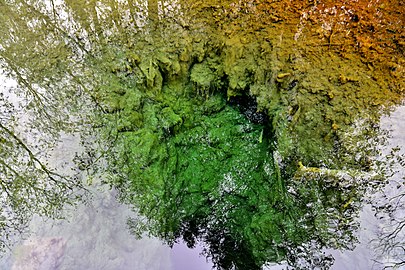


A karst spring or karstic spring is a spring (exsurgence, outflow of groundwater) that is part of a karst hydrological system.
Description
Because of their often conical or inverted bowl shape, karst springs are also known in German-speaking lands as a Topf ("pot") which is reflected in names such as Aachtopf (the source of the Radolfzeller Aach) or Blautopf (the source of the Blau river in Blaubeuren).
Karst springs often have a very high yield or discharge rate, because they are often fed by underground drainage from a large catchment basin. Because the springs are usually the terminus of a cave drainage system at the place where a river cave reaches the Earth's surface, it is often possible to enter the caves from karst springs for exploration.
Large karst springs are located in many parts of the world; the largest ones are believed to be in Papua New Guinea, with others located in Mediterranean countries such as Bosnia and Herzegovina, Croatia, Turkey, Slovenia, and Italy.
Types
An estavelle or inversac is a ground orifice which, depending on weather conditions and season, can serve either as a sink or as a source of fresh water. It is a type of sinkhole.
A Vauclusian spring is a spring that originates from a shaft or a cave system, with the water surging upwards under relatively high pressure. It is named after the Fontaine de Vaucluse in southern France.
Submarine karst springs, also known as vruljas, occur worldwide, and are most numerous in shallow waters of the Mediterranean Sea. They can be considered to be karst springs which have become submerged by rising sea levels.
For intermittent or rhythmic springs see below. They are part of another type of classification, which differentiates between perennial (with continuous flow), rhythmic, and temporary springs.
Hydrological features
A main feature of karst springs is that water is rapidly transported by caverns, so that there is minimal filtering of the water and little separation of different sediments. Groundwater emerges at the spring within a few days from precipitation. Storms, snowmelt, and general seasonal changes in rainfall have a very noticeable and rapid effect on karst springs.
Many karst springs dry up during the driest part of the year, and are thus known as intermittent springs. Still others are dry most of the year round and only flow after heavy rain. Sources that only flow during wet years are often known in German as Hungerbrunnen ("hunger springs"), since folklore claimed a connection between the flow rate of a spring and poor crop yield in a wet year. This appears to be more of a culturally-related superstition, as scientific studies on various Hungerbrunnen have not confirmed such a relationship. An example is the Hungerbrunnen in the parish of Heuchlingen near Gerstetten.
The properties of karst springs make them unsuitable for the supply of drinking water. Their uneven flow rate does not support a steady rate of consumption, especially in summer when there is lower discharge but higher demand. In addition, poor filtering and high hardness mean that the water quality is poor.
Cultural references
The French Realist painter Gustave Courbet (1819–1877) painted a number of karst springs among many landscapes he depicted in the Jura region of eastern France.
Gallery
-
 Fontaine-de-Vaucluse, karst spring of the Sorgue, characterised by an upward movement of water from the depth of over 315 metres (1,033 ft)
Fontaine-de-Vaucluse, karst spring of the Sorgue, characterised by an upward movement of water from the depth of over 315 metres (1,033 ft)
-
 A submarine karst spring (vrulja), observed through sea surface rippling near Omiš
A submarine karst spring (vrulja), observed through sea surface rippling near Omiš
-
 Rhumequelle (Rhume Spring), source of the Rhume, in Herzberg am Harz-Rhumasprung (de) right next to Rhumspringe
Rhumequelle (Rhume Spring), source of the Rhume, in Herzberg am Harz-Rhumasprung (de) right next to Rhumspringe
-
Maramec Spring in the Ozarks, Missouri
-
 "Witch's Well" karst spring in Tuhala, Estonia
"Witch's Well" karst spring in Tuhala, Estonia
-
 The Mshentsy spring, Bologovsky district, Tver region, Russia
The Mshentsy spring, Bologovsky district, Tver region, Russia
See also
References
- Rogulj, Daniela (2016-10-04). "Drone footage of the Cetina like you have never seen before". Total Croatia News. Archived from the original on 2016-10-08.
- Whittow, John (1984). Dictionary of Physical Geography. London: Penguin, 1984, p. 291. ISBN 0-14-051094-X.
- Ford, Derek; Williams, Paul D. (2013). Karst Hydrogeology and Geomorphology. John Wiley & Sons. ISBN 9781118684993.
- ^ Elmer LaMoreaux, Philip (2001). "Geologic/Hydrogeologic Setting and Classification of Springs". Springs and Bottled Waters of the World: Ancient History, Source, Occurrence, Quality and Use. Springer. p. 57. ISBN 978-3-540-61841-6.
- "Geopark Schwäbische Alb". www.geopark-alb.de.
- "Karst Features of Germany: Hungerbrunnen". showcaves.com.
- LaMoreaux, Phillip (2012). Springs and Bottled Waters of the World. US: Springer. pp. 56, 57, 58. ISBN 978-3540618416.
- Fumey, Gilles (2007). "Courbet, peintre du calcaire". Karstologia: Revue de Karstologie et de Spéléologie Physique (in French). 50: 49–51. doi:10.3406/karst.2007.2611.
External links
- Karst springs in Germany (in German)
- The Hungerbrunnen in the Leinleiter valley (in German)
| Cave topics | |
|---|---|
| Glossary of caving and speleology | |
| Main topics | |
| Types and formation processes | |
| Speleothems and Speleogens (Cave formations) | |
| Dwellings | |
| Popular culture | |
| Incidents | |